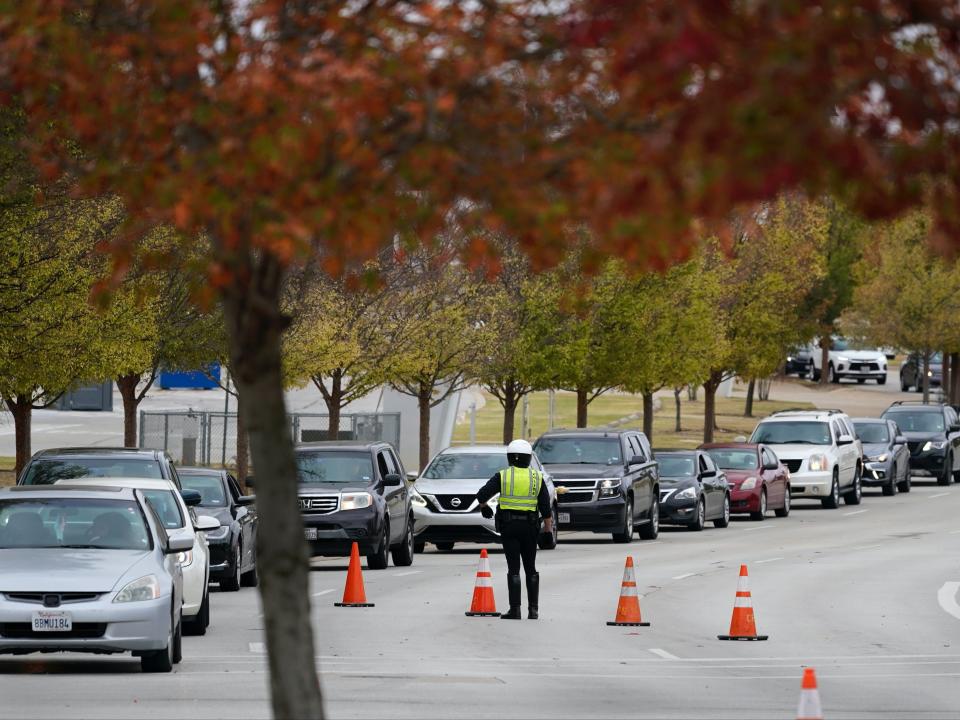Americans join miles-long queues at food banks across the US as thousands face hunger during pandemic

In Texas, hundreds of vehicles lined up to pick up food ahead of Thanksgiving
(AP)Americans across the United States have lined up in miles-long queues at food banks after thousands lost their jobs amid the coronavirus pandemic.
The rise in food insecurities among the public comes as the unemployment rate from Covid-19 has risen faster in three months compared to what it did in two years of the Great Recession, according to the Pew Research Centre.
In response, those impacted have turned to charities like food banks in order to put food on the table.
Feeding America, a national food bank nonprofit, reported about 35 million Americans were impacted with food poverty in 2019. The nonprofit estimated that number could grow an additional 17 million from the pandemic, meaning more than 50 million Americans could need food assistance by the end of 2020.
“About 40 per cent of the people who are turning to us for help have never before relied upon the charitable food system,” said Claire Babineaux-Fontenot, CEO of Feeding America. “Unfortunately, the food crisis persists.”
States like California, New York, Wisconsin, Texas, Pennsylvania, Michigan, and South Carolina, as well as others, have reported long lines at their food banks with people waiting hours to pick up items.
In Los Angeles, volunteers estimated more than 1,000 people lined up on Saturday outside one food bank alone to pick up items, CNN reports. CityTeam, a charity that serves the Santa Clara area of California, reported families in need rose from the organisation helping 1,400 households a month in February to 4,400 households a month in November.
Similarly food banks have reported increased lines and need across New York State. In response, New York City launched GetFoodNYC to address the increased need from residents for a free meal. The $170m plan will include opening more than 400 food hubs where New Yorkers could pick up food or for-hire delivery drivers can deliver directly to them.
In Austin, Texas, about 1,400 cars lined up outside one food bank on Monday morning during the last major handout prior to the Thanksgiving holiday.
Car lines also formed in Coloma, Michigan, on Monday as hundreds waited to pick up a free meal for Thanksgiving.
The US unemployment rate rose to a record high of 14.7 per cent in April, according to the Bureau of Labor Statistics. That number has since declined to 6.9 per cent unemployed in October, but the level still causes concern about the potential “food cliff” charities are bracing for this year.
Most food given out to people is donated, but organisations like the Boy Scouts of America were forced to postpone their food drives due to the pandemic.
Instead, charities like City Harvest, a New York-based organisation, have turned to purchasing food in order to address the overwhelming need. Between the months of March and November, the organisation spent $10m on food, CNBC reports. That number, which was significantly larger than the $208,000 the organisation typically spent per fiscal year, was only expected to increase.
“We don’t see the numbers diminishing,” CEO Jilly Stephens told the publication. “When the days get colder and shorter, people need that food.”
If demand were to continue without the necessary funding and resources, organisations like City Harvest will face a “food cliff” where they will have to cut back on supplies.
Ms Stephens said the organisation was expecting its biggest surge in demand to happen in January after federal assistance programmes expire at the end of this year.
Read More
YouTube suspends OAN after network shares fake coronavirus cure
CDC may soon reduce the 14-day quarantine after Covid exposure
Vaccines may not prevent the transmission of Covid-19, doctor warns

 Yahoo Finance
Yahoo Finance 